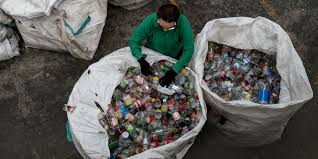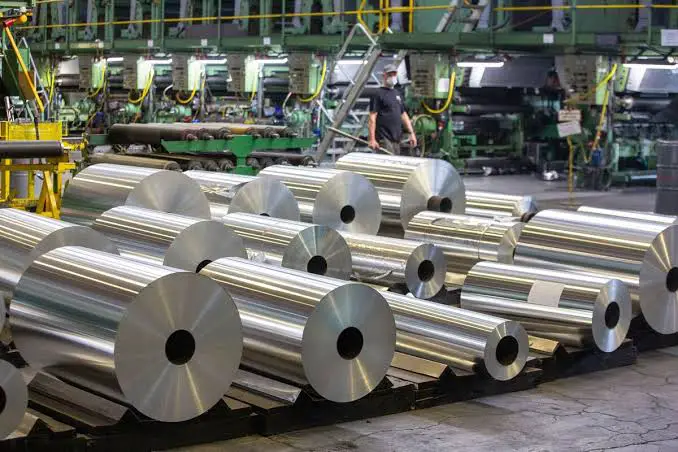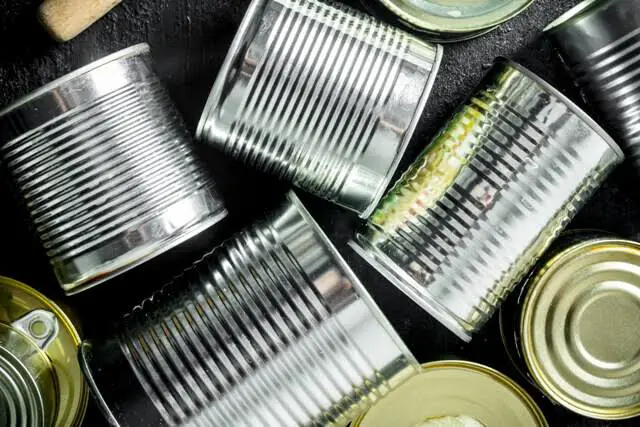Turning wastes into aluminum foil, that means the cans you throw away could become something useful again. It’s like magic but it’s actually science. First, the cans are collected. Then, they are cleaned and sorted. After that, they are melted down. This melting turns them into a liquid. This liquid is then shaped into thin sheets, these sheets are what we know as aluminum foil.
This foil can be used for many things like wrapping food or covering dishes. So, instead of throwing away aluminum cans, they can be recycled into something helpful. Recycling is good for the environment because it saves resources and reduces waste. It’s like giving the cans a new life!
Once the aluminum cans are collected, they are taken to a recycling facility. At the facility, the cans go through a process to make them ready for recycling. They are sorted based on their type and color. This helps ensure that only aluminum cans are used to make aluminum foil.
Next, the cans are cleaned to remove any dirt, labels, or other materials. Clean cans are important because they help produce high-quality aluminum foil. After cleaning, the cans are crushed into small pieces. This makes it easier to melt them down.
The crushed aluminum pieces are then melted in a furnace at a very high temperature. This melting process turns the solid aluminum into a liquid. The liquid aluminum is then poured into molds to create ingots or large blocks.
These ingots are then rolled out into thin sheets using a process called rolling. This rolling process helps make the aluminum thinner and more flexible. The thin sheets are then coiled up to form rolls of aluminum foil.
Finally, the rolls of aluminum foil are packaged and shipped out to stores where they can be bought and used by people like you and me. And the cycle continues – when we’re done with the aluminum foil, we can recycle it again to make more aluminum products.
So, by recycling aluminum cans into aluminum foil, we are not only reducing waste but also conserving energy and resources. It’s a win-win for the environment and for us!
Read Also: Guide to Waste Management Industry Trends
Types of Recyclable Aluminum Cans Wastes and their Uses

There are different types of recyclable aluminum cans wastes, and each type can be used for various purposes:
1. Soda Cans: These are the most common type of aluminum cans wastes. Once recycled, they can be used to make new soda cans, as well as other aluminum products like bicycle frames, car parts, or even aircraft components.
2. Beer Cans: Similar to soda cans, beer cans can also be recycled to make new beer cans or other aluminum items. Additionally, they can be melted down to create aluminum sheets for building materials or packaging.
3. Energy Drink Cans: These cans are often made of aluminum and can be recycled to produce new energy drink cans or aluminum foil for packaging food.
4. Canned Food Containers: Aluminum cans used for packaging canned food items can be recycled to make new cans or aluminum foil. They can also be repurposed into household items like utensils or decorative items.
5. Aluminum Aerosol Cans: Aerosol cans used for products like spray paint, deodorant, or cooking spray are typically made of aluminum. After recycling, they can be used to create new aerosol cans or aluminum sheets for construction or automotive purposes.
6. Aluminum Beverage Pouches: Some beverages are packaged in aluminum pouches instead of cans. These pouches can be recycled to make new pouches or other aluminum products.
7. Aluminum Bottle Caps: Bottle caps made of aluminum can also be recycled. They can be melted down and used to make new caps or other aluminum items.
Overall, recycling these different types of aluminum cans wastes helps conserve resources, reduce energy consumption, and minimize environmental impact. It’s important to properly sort and recycle aluminum cans to ensure they can be reused in various ways.
How to Convert Aluminum Cans Wastes into Aluminum Foil

Converting aluminum cans wastes into aluminum foil involves several steps:
1. Collection: First, aluminum cans are collected from recycling bins, collection centers, or curbside recycling programs. It’s important to gather clean and empty cans for the recycling process.
2. Sorting and Cleaning: Once collected, the cans are sorted and cleaned to remove any contaminants like dirt, liquids, or other materials. This ensures that only aluminum cans are used in the recycling process.
3. Melting: The cleaned aluminum cans are then melted down in a furnace at high temperatures. This melting process turns the solid aluminum into a liquid form, which is essential for shaping it into foil.
4. Shaping into Sheets: The liquid aluminum is poured into molds to create ingots or large blocks. These ingots are then rolled out into thin sheets through a process called rolling. Rolling helps make the aluminum thinner and more flexible, which is necessary for producing aluminum foil.
5. Coiling and Packaging: The thin sheets of aluminum foil are coiled up into rolls. These rolls are then packaged and prepared for distribution to stores and consumers.
6. Reuse and Recycling: Once the aluminum foil is used, it can be recycled again to make new aluminum products. This completes the recycling loop and reduces the need for extracting new aluminum from raw materials.
By following these steps, aluminum cans wastes can be transformed into versatile aluminum foil, which can be used for various purposes in households, restaurants, and industries. Recycling aluminum cans not only conserves resources but also helps reduce waste and minimize environmental impact.
The Benefits of Converting Aluminum Cans Wastes into Aluminum Foil
Converting aluminum cans wastes into aluminum foil offers numerous benefits:
1. Resource Conservation: Recycling aluminum cans reduces the need for extracting new aluminum from raw materials like bauxite ore. This helps conserve natural resources and reduces the environmental impact of mining.
2. Energy Savings: The recycling process for aluminum requires significantly less energy compared to producing aluminum from scratch. Recycling aluminum cans into foil consumes only about 5% of the energy needed to create aluminum from bauxite ore.
3. Waste Reduction: By recycling aluminum cans, less waste ends up in landfills or incinerators. This helps reduce pollution and conserves valuable landfill space.
4. Greenhouse Gas Emissions Reduction: Recycling aluminum emits fewer greenhouse gases compared to producing new aluminum. It helps mitigate climate change by reducing carbon dioxide and other emissions associated with mining, refining, and processing raw materials.
5. Economic Benefits: Recycling aluminum cans creates jobs in collection, sorting, processing, and manufacturing. It also generates revenue from selling recycled aluminum and reduces the cost of waste management for municipalities and businesses.
6. Versatile Uses: Aluminum foil made from recycled cans has various practical applications. It can be used for food packaging, cooking, insulation, and even crafting. Its versatility makes it a valuable material in both residential and commercial settings.
7. Environmental Protection: Recycling aluminum cans helps protect ecosystems and wildlife habitats by reducing the environmental impact of mining activities. It minimizes soil erosion, water pollution, and habitat destruction associated with extracting raw materials.
8. Community Engagement: Recycling aluminum cans encourages community participation in environmental conservation efforts. It promotes awareness about the importance of recycling and encourages responsible consumption habits among individuals and businesses.
Overall, converting aluminum cans wastes into aluminum foil contributes to a more sustainable and circular economy. It conserves resources, reduces pollution, and fosters economic growth while promoting environmental stewardship and community engagement.
Read Also: Strategies for Reducing Waste to Fuel Business
The Uses and Benefits of Recycled Aluminum Foil

Recycled aluminum foil offers a multitude of uses and benefits:
1. Food Packaging: Recycled aluminum foil is commonly used for wrapping and storing food items. It helps preserve freshness, prevents moisture loss, and protects food from contamination. Additionally, it can be easily molded to cover various shapes and sizes of food containers.
2. Cooking and Baking: Aluminum foil made from recycled material is widely used for cooking and baking purposes. It can be used to line baking sheets, wrap vegetables or meats for roasting, and create foil packets for grilling. Its heat conductivity allows for even cooking and helps retain moisture in the food.
3. Insulation: Recycled aluminum foil can be used as insulation in buildings to regulate temperature and reduce energy consumption. It reflects heat and light, helping to keep spaces cool in the summer and warm in the winter. It can also be used as a radiant barrier in attics and walls to improve energy efficiency.
4. Crafting and DIY Projects: Aluminum foil made from recycled material is a popular material for crafting and DIY projects. It can be used to create sculptures, artwork, decorations, and even jewelry. Its versatility and malleability make it ideal for various creative endeavors.
5. Household Cleaning: Recycled aluminum foil can be used for various household cleaning tasks. It can be crumpled into balls and used as a scrubbing pad for removing stubborn stains from pots, pans, and surfaces. It’s also effective for polishing silverware and metal surfaces.
6. Barbecue and Grilling: Recycled aluminum foil is often used for grilling and barbecue purposes. It can be used to wrap foods like vegetables, fish, or potatoes before placing them on the grill. It helps prevent food from sticking to the grill grates and makes cleanup easier.
7. Art and Sculpture: Artists and sculptors often use recycled aluminum foil as a medium for creating sculptures and artwork. Its pliability allows for intricate detailing and sculpting techniques. Additionally, its reflective surface can add visual interest and depth to art pieces.
8. Environmental Benefits: Using recycled aluminum foil reduces the demand for virgin aluminum, which requires extensive mining and processing. By choosing recycled foil, individuals and businesses can help conserve natural resources, reduce energy consumption, and minimize environmental impact.
Overall, recycled aluminum foil offers a wide range of practical applications and environmental benefits. Its versatility, durability, and sustainability make it a valuable resource in various industries and everyday life.
The Challenges of Converting Aluminum Cans Wastes into Aluminum Foil and their Solutions
Converting aluminum cans wastes into aluminum foil presents some challenges, but there are solutions to address them:
1. Contamination: Contamination of aluminum cans with other materials like food residue or non-aluminum metals can affect the quality of the recycled aluminum foil.
Solution: Implementing effective sorting and cleaning processes at recycling facilities can help remove contaminants and ensure that only clean aluminum cans are used for recycling.
2. Energy Consumption: The melting and rolling processes involved in converting aluminum cans into foil require significant energy inputs.
Solution: Investing in energy-efficient technologies and practices, such as using renewable energy sources for melting and optimizing heating and rolling processes, can help reduce energy consumption and lower production costs.
3. Transportation and Logistics: Transporting aluminum cans from collection points to recycling facilities and then distributing the recycled aluminum foil to manufacturers and consumers involves logistical challenges and carbon emissions.
Solution: Developing efficient transportation networks and logistics strategies, such as optimizing routes, utilizing eco-friendly vehicles, and consolidating shipments, can help minimize transportation-related costs and emissions.
4. Quality Control: Ensuring consistent quality and purity of recycled aluminum foil is essential for its usability and marketability.
Solution: Implementing strict quality control measures, including regular inspections, testing, and certification processes, can help maintain high-quality standards and meet customer requirements.
5. Market Demand and Pricing: Fluctuations in market demand and pricing for recycled aluminum foil can affect the viability of recycling operations.
Solution: Diversifying product offerings and expanding market reach to include industries beyond packaging, such as construction, automotive, and aerospace, can help mitigate market risks and create additional revenue streams.
6. Public Awareness and Participation: Encouraging public awareness and participation in aluminum can recycling programs is crucial for ensuring a steady supply of raw materials for aluminum foil production.
Solution: Implementing educational campaigns, offering incentives for recycling, and improving accessibility to recycling infrastructure can help increase public engagement and participation in recycling efforts.
By addressing these challenges with effective solutions, the conversion of aluminum cans wastes into aluminum foil can be optimized for maximum environmental, economic, and social benefits. Collaboration between stakeholders, including government agencies, recycling facilities, manufacturers, and consumers, is key to overcoming these challenges and promoting sustainable recycling practices.
Frequently Asked Questions (FAQs) About How to Convert Aluminum Cans Wastes into Aluminum Foil
1. Q: How are aluminum cans recycled into aluminum foil?
A: Aluminum cans are first collected and sorted at recycling facilities. Then, they undergo a process where they are cleaned, melted down, and shaped into thin sheets through rolling. These sheets are then coiled into rolls of aluminum foil.
2. Q: What types of aluminum cans can be used to make aluminum foil?
A: Various types of aluminum cans, including soda cans, beer cans, energy drink cans, canned food containers, aerosol cans, beverage pouches, and bottle caps, can be recycled to produce aluminum foil.
3. Q: Is recycled aluminum foil as good as foil made from virgin aluminum?
A: Yes, recycled aluminum foil has similar properties and performance to foil made from virgin aluminum. It is equally effective for packaging, cooking, insulation, and other uses.
4. Q: What are the environmental benefits of converting aluminum cans wastes into aluminum foil?
A: Converting aluminum cans into aluminum foil helps conserve natural resources, reduce energy consumption, minimize waste, and lower greenhouse gas emissions. It also mitigates the environmental impacts of mining and processing raw materials.
5. Q: Can I recycle aluminum foil after I use it?
A: Yes, aluminum foil can be recycled after use. Simply clean off any food residue and place it in the recycling bin along with other aluminum items. Recycling aluminum foil helps close the loop on the recycling process and reduces waste.
6. Q: How can I ensure that the aluminum foil I buy is made from recycled material?
A: Look for products labeled as “recycled aluminum foil” or check the packaging for information about the material’s source. Many brands now offer aluminum foil made from recycled material, which helps support sustainable practices.
7. Q: Are there any downsides to recycling aluminum cans into aluminum foil?
A: While recycling aluminum cans into aluminum foil offers numerous benefits, challenges such as contamination, energy consumption, and market demand fluctuations can impact the process. However, these challenges can be addressed through effective recycling practices and industry innovations.
Read Also: Vanilla Flower (Vanilla planifolia): All You Need To Know About

